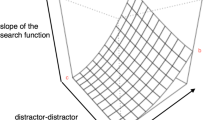Abstract
Touch screen interface design directly affects user’s understanding and operation to interface. In human-computer interaction, users find the target icon by visual searching, so visual search is the most important process. There are many kinds of interface style in modern interface design. This paper take four different icon styles as research object: such as line style, Metro style, flat style and skeuomorphism style. By the eye movement experiment about visual research, we arrival at conclusions as follows: In visual search tasks, there is different efficiency in different icon styles; Users have the highest search efficiency in abstract icons such as line style icons and Metro style icons, second in flat icons, and the lowest in skeuomorphism icons. Finally we can conclude differences in visual search. Using the users’ visual search habits as interface design accordance, can improve user experience of human-machine interaction.
Access this chapter
Tax calculation will be finalised at checkout
Purchases are for personal use only
Similar content being viewed by others
References
Minghai, S., Haoxiang, T.: Application of flat style in the design of mobile phone UI. J. Design (7), 34–35 (2016). (in Chinese)
Zhenglin, W.: The idea and direction of UI design: take windows UI for example. J. Decor. (02), 138–139 (2015). (in Chinese)
Sheng, Z.: Aesthetic discussion of flat UI style design. J. Art Panor. (6), 121 (2014). (in Chinese)
Feng, Z., Shuang, L.: The development trend research on user interface of mobile phone. J. Design (5), 134–135 (2016). (in Chinese)
Treisman, A.M., Gelade, G.: A feature-integration theory of attention. Cogn. Psychol. 12, 97–136 (1980)
Sheree, J., Michael, E.H.: Visual attention to repeated internet images: testing the scanpath theory on the world wide web. In: Proceedings of the Symposium on ETRA 2002: Eye Tracking Tesearch and Applications Symposium, pp. 43–49; 112–120. ACM, New Orleans (2002)
Yarbus, A.L.: Eye Movements and Vision. Plenum Press, New York (1967)
Wickens, C.D., Hollands, J.G.: Engineering Psychology & Human Performance. Taylor and Francis, Engelska (2015)
Williams, D.E., Reingold, E.M., Moscovitch, M., Behrmann, M.: Patterns of eye movements during parallel and serial visual search tasks. Can. J. Exp. Psychol. 51, 151–164 (1997)
Posner, M.I., Cohen, Y.: Components of Visual Orienting, pp. 531–556. Erlbaum, Hillsdale (1984)
Godijn, R., Theeuwes, J.: Inhibition-of-return and coulometer interference. J. Vis. Res. 44(12), 1485–1492 (2004)
Tagare, H.D., Toyama, K., Wang, J.G.: A maximum-likelihood strategy for directing attention during visual search. IEEE Trans. Pattern Anal. Mach. Intell. 23(5), 490–500 (2001)
Young, L., Sheena, D.: Methods & designs: survey of eye movement recording methods. J. Behav. Res. Methods Instrum. 7(5), 224–397 (1975)
Dewar, R.E., Olson, P.L.: Human Factor in Traffic Safety. Lawyers and Judges Publishing Company, Inc., Tucson (2001)
Acknowledgments
This work was supported by Research Funds for the Central Universities (Grant No. 2016B55014), Graduate Innovation Project of Hohai University (Grant No. SJLX16_0211), Fundamental Research Funds for the Central Universities (Grant No. 2015B22714), the National Nature Science Foundation of China (Grant No. 71601068, 61603123), and science and technology projects of Changzhou (CJ20140033).
Author information
Authors and Affiliations
Corresponding author
Editor information
Editors and Affiliations
Rights and permissions
Copyright information
© 2018 Springer International Publishing AG
About this paper
Cite this paper
Xi, T., Wu, X. (2018). The Influence of Different Style of Icons on Users’ Visual Search in Touch Screen Interface. In: Rebelo, F., Soares, M. (eds) Advances in Ergonomics in Design. AHFE 2017. Advances in Intelligent Systems and Computing, vol 588. Springer, Cham. https://doi.org/10.1007/978-3-319-60582-1_22
Download citation
DOI: https://doi.org/10.1007/978-3-319-60582-1_22
Published:
Publisher Name: Springer, Cham
Print ISBN: 978-3-319-60581-4
Online ISBN: 978-3-319-60582-1
eBook Packages: EngineeringEngineering (R0)




